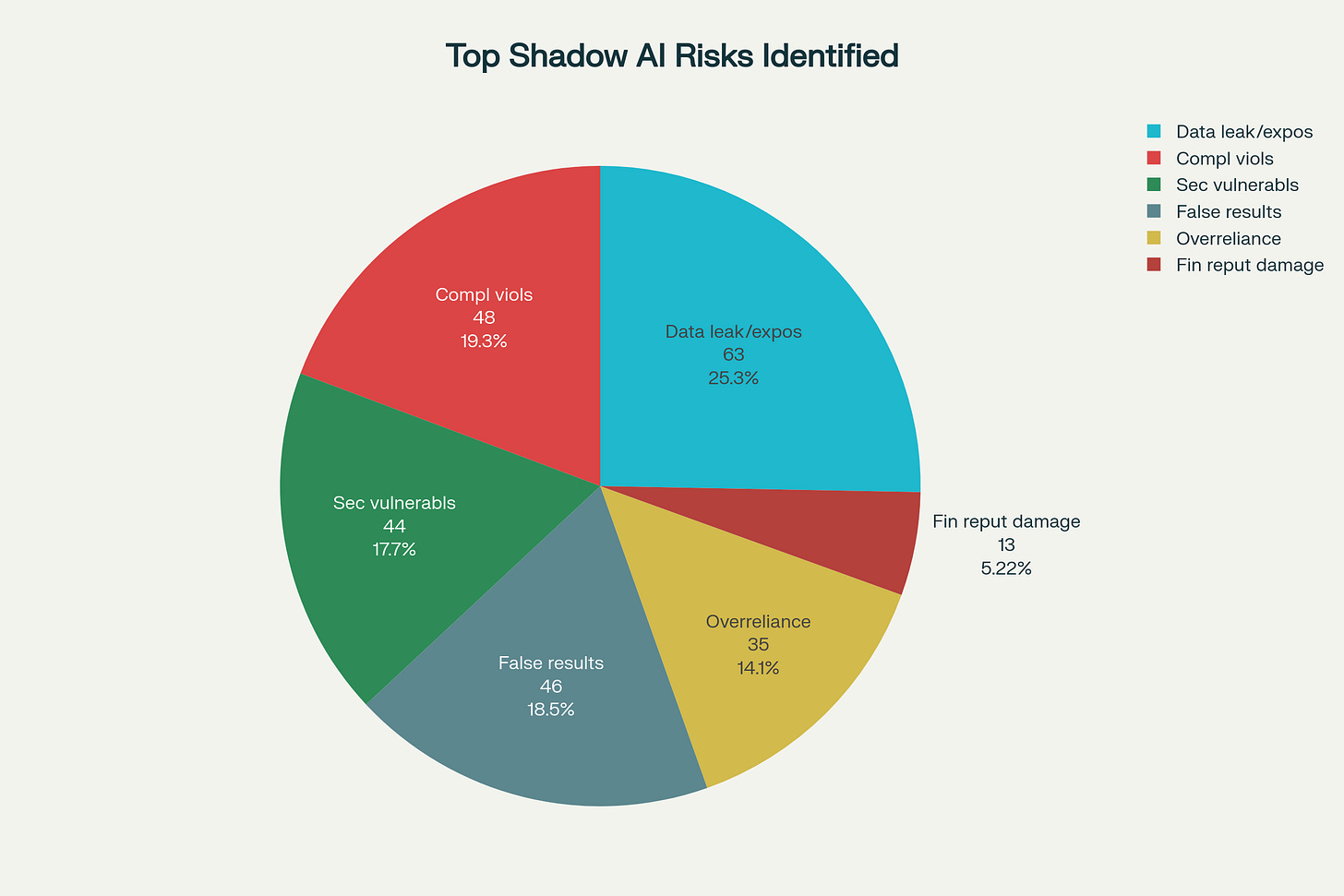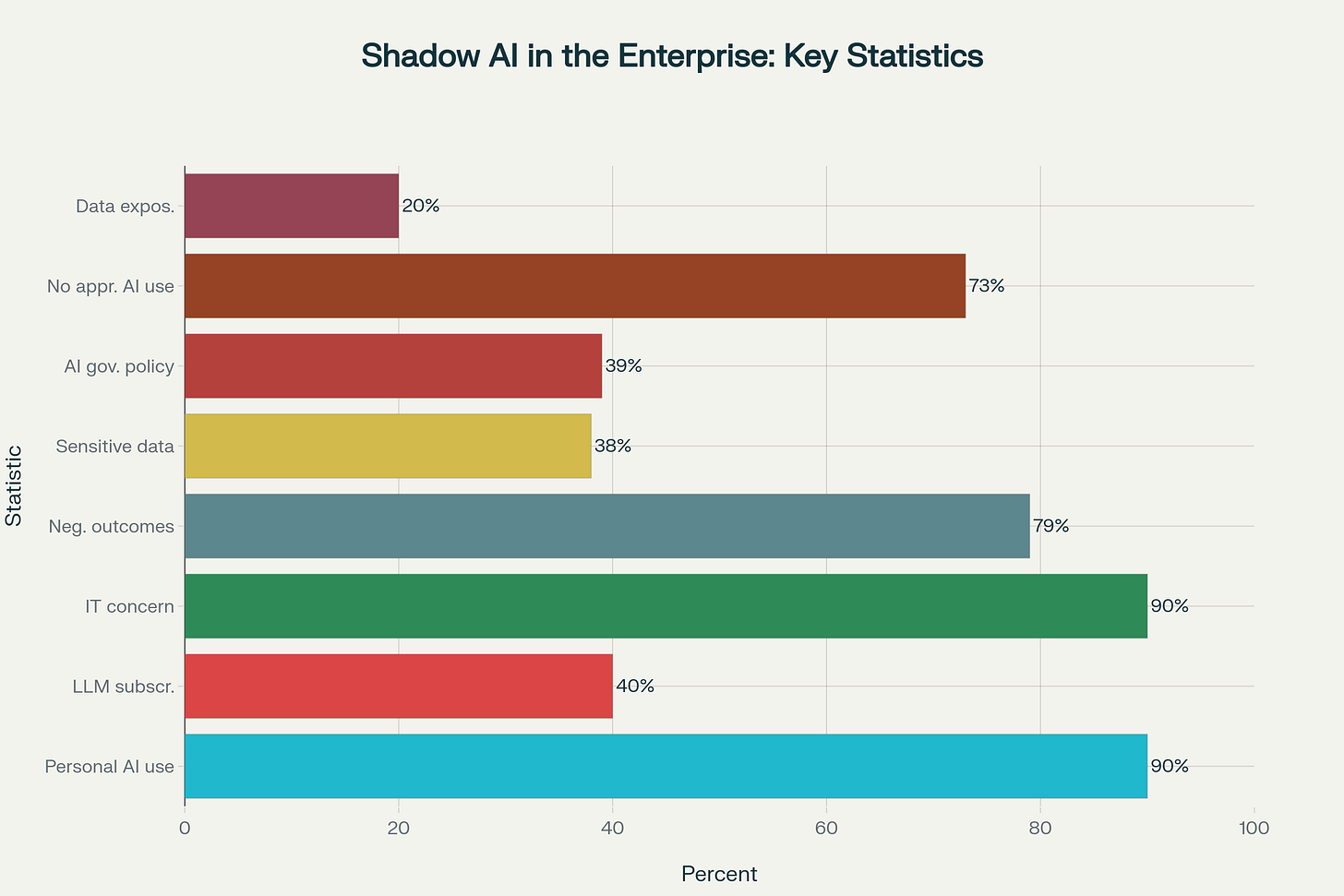Shadow AI: Balancing Innovation and Risk in the Workplace
Discover the rise of shadow AI, its risks, key statistics, and strategies for SMBs and enterprises. Learn how to balance innovation with governance
Artificial intelligence has become deeply embedded in everyday work. From generating reports to drafting emails, employees are using AI tools to move faster and get more done. But not all of this activity is visible to company leadership. Much of it takes place in the shadows, through personal accounts or unapproved tools-a phenomenon now known as shadow AI.
Shadow AI presents both opportunity and risk. On one hand, it shows the speed and creativity of employees eager to innovate. On the other, it raises serious questions around data security, compliance, and long-term governance. For leaders, the challenge is not to suppress this energy but to guide it with proactive oversight and awareness.
What is Shadow AI?
Shadow AI refers to the use of artificial intelligence tools and applications by employees without formal approval or oversight. It is a subset of the long-standing issue of “shadow IT,” but with sharper risks due to AI’s ability to process sensitive data and generate outputs that may not be easily traceable or explainable.
Examples include:
A marketer pasting customer information into a free chatbot
A developer using an AI coding assistant without security review
A consultant feeding confidential documents into a public summarization tool
What makes shadow AI unique is that unlike static software, these tools learn from user inputs and often operate outside enterprise safeguards. This creates risks not only of data leaks, but also of regulatory breaches and reputational damage.
Shadow AI: Key Trends and Data
The rise of shadow AI is widespread and accelerating. Employees use it because it is fast, simple, and effective-often outperforming official enterprise systems in convenience.
Key statistics show the scale of the issue:
90% of companies report employees using personal AI accounts at work
73% of knowledge workers use AI tools in their daily workflow without approval
38% of employees admit to sharing sensitive data with unauthorized AI applications
63% of software developers use generative AI unofficially
79% of organizations have experienced negative outcomes from corporate data being sent to AI tools
20% of global data breaches now involve shadow AI systems
$670,000: average additional cost of breaches in organizations with high shadow AI usage
Corporate data volume placed into AI tools grew 485% from March 2023 to March 2024
These numbers underline a critical reality: shadow AI is not a fringe activity. It is already a core part of workplace behavior.
Strategic Approaches for SMBs
Smaller organizations face unique challenges: limited IT resources, fewer compliance staff, and the need to remain agile. At the same time, this agility can be a strength when implementing governance quickly.
Principles for SMBs:
Establish accountability by designating a person or team to oversee AI use
Focus on high-impact, low-risk solutions first (e.g., enterprise-ready AI assistants)
Implement lightweight monitoring to understand usage patterns
Provide clear but simple policies that employees can follow
Train staff in data privacy, prompting, and practical AI use cases
Classify data so employees know what can and cannot be used in AI tools
Step-by-Step Framework for SMBs:
Month 1–2: Foundation. Begin by assigning an AI governance owner-someone who will be accountable for overseeing AI usage across the business. Conduct a simple inventory of which AI tools are already being used by employees, whether officially or unofficially. Draft basic policies that set clear boundaries, such as not uploading customer data into public chatbots.
Month 3–4: Policy Implementation. Roll out the policies to staff, ensuring they are written in plain language and easy to follow. Introduce lightweight monitoring solutions, such as periodic usage surveys or basic SaaS management tools. Launch introductory training programs to cover safe AI use, effective prompting, and common risks.
Month 5–6: Optimization. Review how employees are using AI, identify gaps, and refine policies accordingly. Replace high-risk shadow tools with enterprise-approved alternatives. Encourage feedback from staff to understand which AI solutions are genuinely valuable, then optimize the organization’s AI toolkit to focus on those.
Strategic Approaches for Enterprises
Enterprises must balance innovation with strict compliance, often across thousands of employees and multiple jurisdictions. This demands a more comprehensive governance approach.
Principles for Enterprises:
Establish a cross-functional AI governance committee with executive sponsorship
Maintain a detailed inventory of all AI tools, models, and data assets
Deploy technical controls such as role-based access, DLP systems, and API gateways
Monitor AI use continuously with SaaS management platforms and anomaly detection
Provide enterprise-grade AI ecosystems to reduce reliance on unapproved tools
Align policies with global frameworks such as GDPR, HIPAA, and the EU AI Act
Step-by-Step Framework for Enterprises:
Months 1–6: Assessment and Foundation. Begin with a comprehensive discovery process to understand where shadow AI exists within the organization. Establish a governance committee with representatives from IT, legal, compliance, and business units. Draft initial policies that define acceptable and unacceptable AI usage.
Months 6–12: Control Deployment. Implement technical controls such as access management, container security policies, and proxy services for interactions with external AI systems. Deploy monitoring platforms to track AI activity and detect anomalies. At the same time, roll out approved AI platforms to provide safe alternatives.
Months 12–24: Optimization and Maturation. Scale training programs across the organization, with a focus on building AI literacy among all employees. Refine governance policies based on usage analytics and emerging regulatory requirements. Expand the approved AI ecosystem to include specialized tools while maintaining strong oversight.
Key Recommendations
The shadow AI economy represents both the greatest governance challenge and the most significant strategic opportunity facing organizations today. Rather than attempting to eliminate shadow AI through restrictive policies, successful organizations are learning to harness its innovation potential while mitigating associated risks.
For SMBs: Focus on practical, lightweight governance that enables innovation while protecting critical assets. Leverage your agility advantage to implement solutions quickly and iterate based on results.
For Enterprises: Implement comprehensive governance frameworks that balance control with enablement. Transform shadow AI from a hidden risk into a managed competitive advantage through proper oversight and approved alternatives.
Universal Principles:
Enable rather than restrict: Provide better alternatives to shadow tools
Focus on risk-based governance: Prioritize controls based on actual impact
Maintain continuous visibility: Implement monitoring appropriate to organizational scale
Foster AI literacy: Educate employees on responsible AI usage
Embrace the shadow economy: Learn from employee innovation to guide formal AI strategies
The organizations that successfully navigate the shadow AI challenge will be those that recognize it not as a problem to be eliminated, but as an indicator of genuine business needs that must be met through secure, governed channels.
Additional resources:
The VECTR™ Framework: An Operating System for AI Adoption
The FCE™ Framework: A Fast, Focused Way to Measure AI Value
Final Words
Shadow AI is not simply the result of employees breaking rules. It is the result of leadership failing to be proactive. People will always find the tools they need to work faster, whether or not those tools are officially approved.
This is why training and awareness must be the first line of defense. Employees often scratch the surface of what AI can do, jumping between tools without understanding their full potential-or the risks involved. By investing in practical training, realistic expectations, and open conversations, leaders can shift shadow AI from a liability into an asset.
Of course, training alone is not enough. Policy implementation, governance committees, technical controls, and risk management remain essential pillars. But they must be built on a foundation of proactive leadership that embraces innovation while managing its risks.
Ultimately, organizations cannot use every tool on the market. Choices must be made. By selecting wisely, investing in literacy, and guiding employees with clarity, leaders can ensure AI becomes a competitive advantage-rather than a hidden risk.





